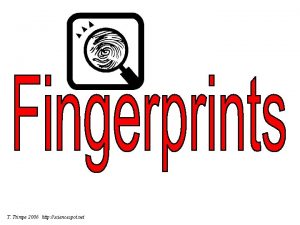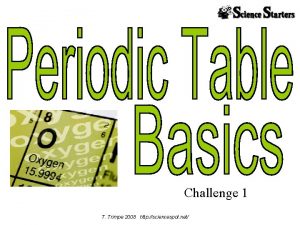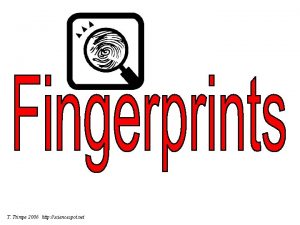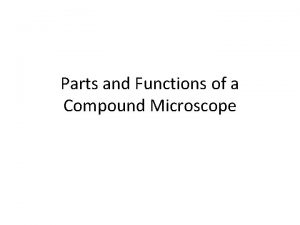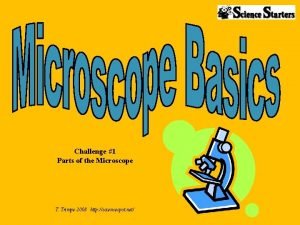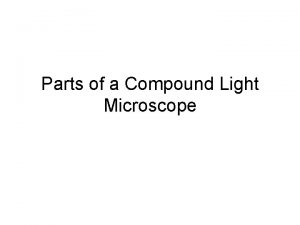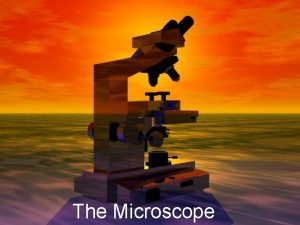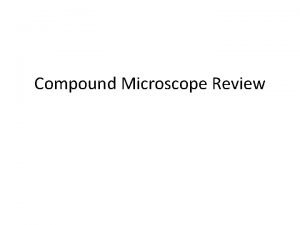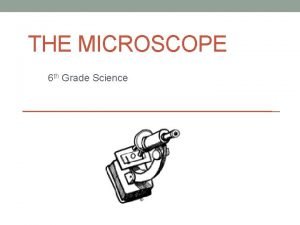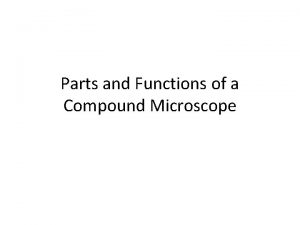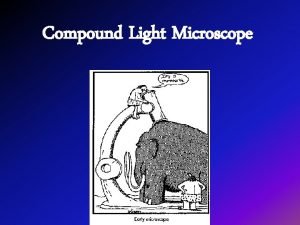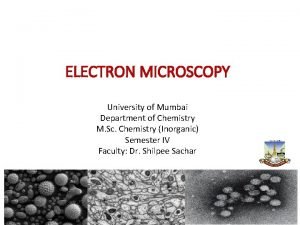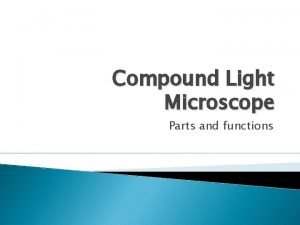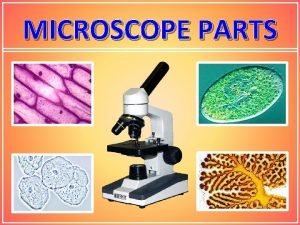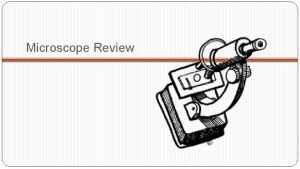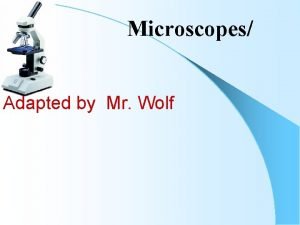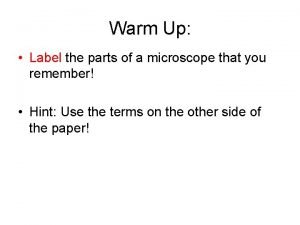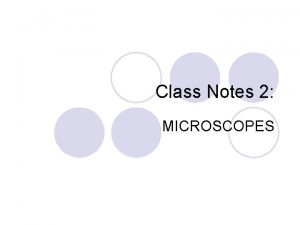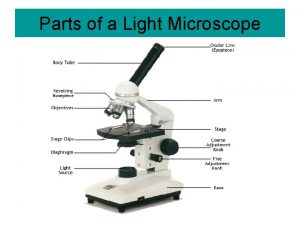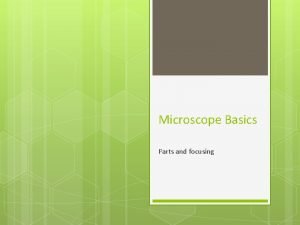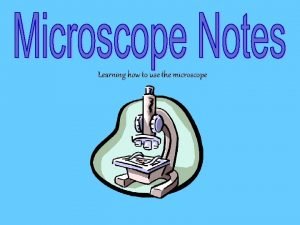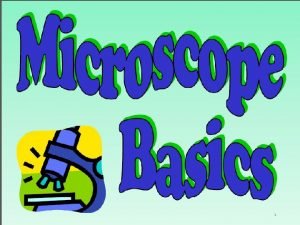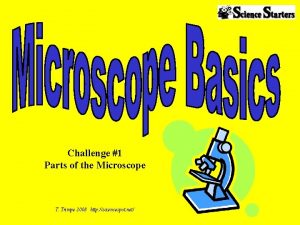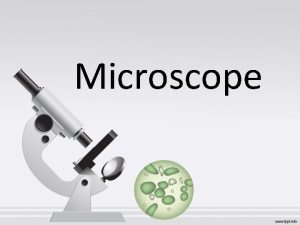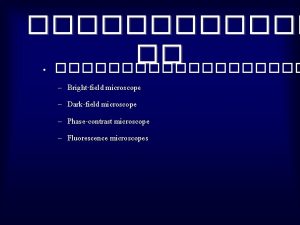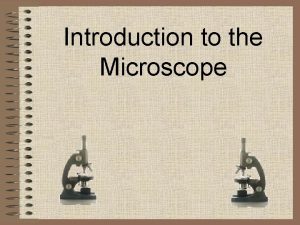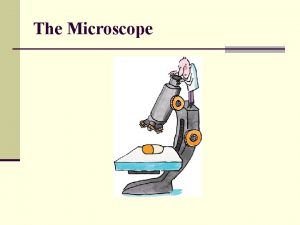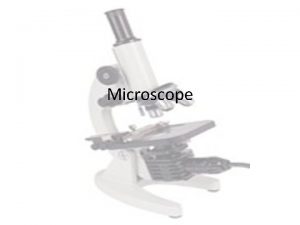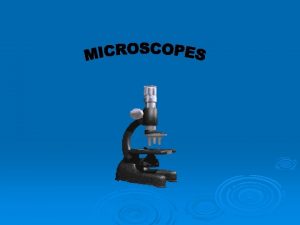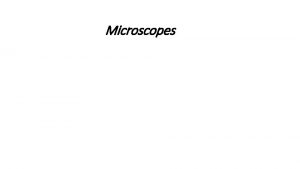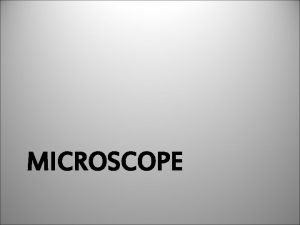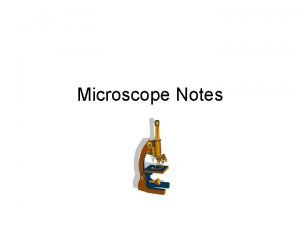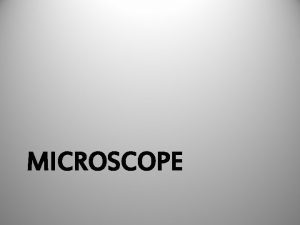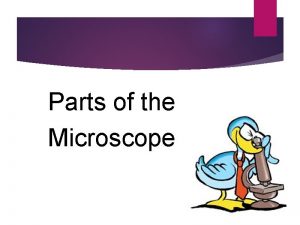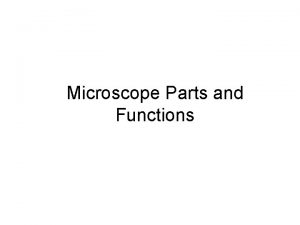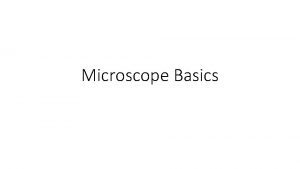Challenge 1 Parts of the Microscope T Trimpe





























































- Slides: 61

Challenge #1 Parts of the Microscope T. Trimpe 2008 http: //sciencespot. net/

Identify the parts of a microscope. Arm Body Tube Coarse Adjustment Diaphragm Fine Adjustment Objective Lenses Ocular Lens Stage D A B C E F G H

The answers are. . . A. Body Tube D A B. Objective Lenses C. Diaphragm D. Ocular Lens B E. Arm F. Stage G. Coarse Adjustment H. Fine Adjustment C E F G H

Challenge #2 Parts of the Microscope T. Trimpe 2008 http: //sciencespot. net/

Label the parts of the microscope using the words provided. Ocular Lens Diaphragm DD Objectives Nosepiece Fine Adjustment Knob Coarse Adjustment Knob AA BB CC EE FF

The answers are … D Nosepiece Objectives Diaphragm Ocular Lens A B C E F Coarse Adjustment Knob Fine Adjustment Knob

Powers of Magnification T. Trimpe 2008 http: //sciencespot. net/

Fill in the missing information in the chart based on your knowledge of powers of magnification. Ocular Lens Objective Lens Power of Magnification 5 20 A 10 B 400 C 10 120

The answers are … Ocular Lens X Objective Lens Power of Magnification = 5 20 100 A 10 40 B 400 12 C 10 120

Challenge #3 What do you know about microscopes? T. Trimpe 2008 http: //sciencespot. net/


The answers are … 1. If you have three objectives – 10 X, 30 X, and 40 X, which one has the lowest power of magnification? 10 X 2. Which of these images would be taken with a high power objective? HIGH POWER 3. How does your view of a specimen change as you increase your power of magnification? You are able to see the specimen in more detail, but you cannot see as much of it.

Challenge #5 What do you know about microscopes? T. Trimpe 2008 http: //sciencespot. net/

Answer each question about microscopes. 1. What part regulates the amount of light on a specimen? 2. If the eyepiece has a power of 12 X and the objective has a power of 10 X, what is the power of magnification? 3. What part of the microscope holds the objective lenses? 4. What part allows you to make small changes in your view of a specimen?

The answers are … 1. What part regulates the amount of light on a specimen? Diaphragm 2. If the eyepiece has a power of 12 X and the objective has a power of 10 X, what is the power of magnification? 12 X x 10 X = 120 X 3. What part of the microscope holds the objective lenses? Nosepiece 4. What part allows you to make small changes in your view of a specimen? Fine adjustment knob

What do you know about microscopes? T. Trimpe 2008 http: //sciencespot. net/

Answer these questions based on your knowledge of microscopes. 1. Where should you hold on to the microscope when you carry it? 2. What is the scientific term for the eyepiece? 3. If the ocular lens has a power of 4 X and the objective you are using has a power of 10 X, what is your power of magnification? 4. What is the function of the diaphragm?

The answers are … 1. Where should you hold on to the microscope when you carry it? Arm & Base 2. What is the scientific term for the eyepiece? Ocular Lens 3. If the ocular lens has a power of 4 X and the objective you are using has a power of 10 X, what is your power of magnification? 4 X x 10 X = 40 X 4. What is the function of the diaphragm? It regulates the amount of light that passes through the specimen.

Crime 360: Scanning Electron Microscope

Watch the video and then answer the questions. 1. Where was the metal fragment found? A. On a shirt B. On a shoe C. On a pair of pants 2. Fill in the missing information in this statement: The scanning electron microscope can ______ a very small sample and determine what materials make it up. 3. How does the special microscope work? A. It creates an image with a beam of electrons. B. It creates an image using lights and mirrors. C. It creates an image by taking a digital image and enlarging it. 4. What type of metal was the fragment? A. Lead B. Aluminum C. Steel

The answers are … 1. Where was the metal fragment found? A. On a shirt B. On a shoe C. On a pair of pants 2. Fill in the missing information in this statement: magnify The scanning electron microscope can ___________ a very small sample and determine what materials make it up. 3. How does the special microscope work? A. It creates an image with a beam of electrons. B. It creates an image using lights and mirrors. C. It creates an image by taking a digital image and enlarging it. 4. What type of metal was the fragment? A. Lead B. Aluminum C. Steel



Comparison Microscope

Scanning Electron Microscope

Scanning Electron Microscope • Scanning Electron Microscope Images • scanning electron microscope • top 10 bugs

Compound Light Microscope

Introduction to the Microscope §Care §Parts §Focusing

• Make sure all backpacks and other items are out of the isles • Always carry with 2 hands by holding the arm and the base. • Only use lens paper for cleaning • Do not force knobs • Always store covered

General Procedures • Always start and end with low power. • Never remove a slide when the high power objective lens is in place - it will scratch the lens! • Always wrap the cord before putting the microscope up. • Always cover the microscope if a cover is available.

Microscope Parts and Functions

Structure and Function of the Microscope • http: //Structure and Function of the Microscope


Ocular lens (Eyepiece) Body Tube Nosepiece Arm Objectives Stage Clips Coarse Adjustment Diaphragm Light Fine Adjustment Base Always carry a microscope with one hand holding the arm and one hand under the base.

Parts of the Microscope




Magnification Total Magnification Focusing Field of View Depth of Field

What’s my power? To calculate the power of magnification, multiply the power of the ocular lens by the power of the objective. What are the powers of magnification for each of the objectives we have on our microscopes? Fill in the table on your worksheet.

Total Magnification

What happens as the power of magnification increases? • Power = 10 x 4 = 40 • Power = 10 x 10 = 100 • Power = 10 x 40 = 400

Comparing Powers of Magnification We can see better details with higher the powers of magnification, but we cannot see as much of the image. Which of these images would be viewed at a higher power of magnification?

Focusing your specimen Focusing Field of View Depth of Field

• Place the Slide on the Microscope • Use Stage Clips • Click Nosepiece to the lowest (shortest) setting • Look into the Eyepiece • Use the Coarse Focus first

Focusing Specimens

Field of View

Field of View • http: //www. microscope. org/advanced/magnification 2. htm • What happens to the field of view as the magnification increases? – Make sure you sketches reflect this.

Depth of Focus

Depth of Focus

Sketching your Specimen

Drawing Specimens • Use a pencil – you can erase and shade areas. (I will allow you to use a small amount of color from colored pencils to help you for your practical. • Drawings should be labeled with specimen name, magnification, and some sort of special notation that will help you remember the slide to study for your practical. • The circle indicates the viewing field. If your specimen takes up the whole viewing field, make sure your drawing reflects that.

Show detail in your sketches!

Show details in your sketching!

Sketch your specimens clearly and accurately! • http: //www. microscope. org/microscopeapplications. htm



Let’s give it a try. . . 1 – Turn on the microscope and then rotate the nosepiece to click the red-banded objective into place. 2 – Place a slide on the stage and secure it using the stage clips. Use the coarse adjustment knob (large knob) to get it the image into view and then use the fine adjustment knob (small knob) to make it clearer. 3 – Once you have the image in view, rotate the nosepiece to view it under different powers. Draw what you see on your worksheet! Be careful with the largest objective! Sometimes there is not enough room and you will not be able to use it! 4 – When you are done, turn off the microscope and put up the slides you used.

Instructions – • • Specimens must be in order – 1 -20 respectively! Number First!! • Slide diagrams MUST be sketched in at least 100 x magnification. • You may sketch in 400 X magnification. • Total magnification should be recorded on specimen sheet. • No slide diagrams may be sketched in 40 X! • You must write some type of descriptive notation that will help you be able to recognize this specimen with the name covered up. You will have a lab practical. • Sketch with neatness and accuracy. • Give me YOUR best.

Forensic Slides Instructions – • Specimens must be in order – 1 -20 respectively! Number First!! • Slide diagrams MUST be sketched in at least 100 x magnification. • You may sketch in 400 X magnification. • No slide diagrams may be sketched in 40 X! • You must write some type of descriptive notation that will help you be able to • recognize this specimen with the name covered up. You will have a lab practical. • Give me YOUR best. 1. Deer hair * slightly broken – be careful 2. Frog Blood Smear 3. Cellulose Paper Fiber 4. Wooly Mammoth Hair 5. Mouse Hair 6. Germinating Pollen 7. Mixed Pollen 8. Sand 9. Human blood 10. Salt Crystals 11. Cat Hair 12. Sawdust 13. Gunshot Residue 14. DNA in Animal Cells 15. Lilium Pollen 16. Common Dust 17. Fiber comparison – bloodstained 18. Dandruff 19. Iron Rust 20. Volcanic Dust

How to make a wet-mount slide … 1 – Get a clean slide and coverslip from your teacher. 2 – Place ONE drop of water in the middle of the slide. Don’t use too much or the water will run off the edge and make a mess! 3 – Place the edge of the cover slip on one side of the water drop. 4 - Slowly lower the cover slip on top of the drop. Cover Slip Lower slowly 5 – Place the slide on the stage and view it first with the red-banded objective. Once you see the image, you can rotate the nosepiece to view the slide with the different objectives. You do not need to use the stage clips when viewing wet-mount slides!
 Sciencespot fingerprint challenge
Sciencespot fingerprint challenge Halide with 6 energy levels
Halide with 6 energy levels Sciencespot fingerprint challenge
Sciencespot fingerprint challenge Compound microscope parts and functions drawing
Compound microscope parts and functions drawing Welcome to teen challenge uk - teen challenge uk
Welcome to teen challenge uk - teen challenge uk Light microscope vs electron microscope
Light microscope vs electron microscope Microscope mania compound light microscope
Microscope mania compound light microscope Parts of a microscope mirror
Parts of a microscope mirror Parts of janssen microscope
Parts of janssen microscope Body tube microscope
Body tube microscope Parts of a microscope
Parts of a microscope Label the parts of a microscope
Label the parts of a microscope Fine adjustment knob microscope function
Fine adjustment knob microscope function Compound microscope
Compound microscope Rotating disc where the objectives are attached
Rotating disc where the objectives are attached Body of microscope
Body of microscope Parts of electron microscope
Parts of electron microscope Parts of the microscope and their functions
Parts of the microscope and their functions Compound microscope parts and functions
Compound microscope parts and functions Parts of microscope
Parts of microscope The body tube
The body tube Scanning objective lens
Scanning objective lens Label the parts of a microscope
Label the parts of a microscope Parts of compound light microscope
Parts of compound light microscope The parts of a light microscope
The parts of a light microscope Label the parts of a compound light microscope
Label the parts of a compound light microscope Magnifying illuminating and mechanical parts of microscope
Magnifying illuminating and mechanical parts of microscope Parts of a microscope
Parts of a microscope Gp2 rec.#9、03/14/18 l. in a compound mcrosope, th...
Gp2 rec.#9、03/14/18 l. in a compound mcrosope, th... Monocular microscope diagram
Monocular microscope diagram Voi kéo gỗ như thế nào
Voi kéo gỗ như thế nào Thiếu nhi thế giới liên hoan
Thiếu nhi thế giới liên hoan Fecboak
Fecboak Một số thể thơ truyền thống
Một số thể thơ truyền thống Thế nào là hệ số cao nhất
Thế nào là hệ số cao nhất Hệ hô hấp
Hệ hô hấp Frameset trong html5
Frameset trong html5 Thế nào là số nguyên tố
Thế nào là số nguyên tố Tư thế ngồi viết
Tư thế ngồi viết đặc điểm cơ thể của người tối cổ
đặc điểm cơ thể của người tối cổ Mật thư tọa độ 5x5
Mật thư tọa độ 5x5 Các châu lục và đại dương trên thế giới
Các châu lục và đại dương trên thế giới Tư thế worms-breton
Tư thế worms-breton ưu thế lai là gì
ưu thế lai là gì Thẻ vin
Thẻ vin Cái miệng xinh xinh thế chỉ nói điều hay thôi
Cái miệng xinh xinh thế chỉ nói điều hay thôi Các châu lục và đại dương trên thế giới
Các châu lục và đại dương trên thế giới Từ ngữ thể hiện lòng nhân hậu
Từ ngữ thể hiện lòng nhân hậu Bổ thể
Bổ thể Tư thế ngồi viết
Tư thế ngồi viết Thứ tự các dấu thăng giáng ở hóa biểu
Thứ tự các dấu thăng giáng ở hóa biểu 101012 bằng
101012 bằng Thể thơ truyền thống
Thể thơ truyền thống Chúa yêu trần thế
Chúa yêu trần thế Khi nào hổ con có thể sống độc lập
Khi nào hổ con có thể sống độc lập đại từ thay thế
đại từ thay thế Diễn thế sinh thái là
Diễn thế sinh thái là Vẽ hình chiếu vuông góc của vật thể sau
Vẽ hình chiếu vuông góc của vật thể sau Công thức tiính động năng
Công thức tiính động năng Tỉ lệ cơ thể trẻ em
Tỉ lệ cơ thể trẻ em Thế nào là mạng điện lắp đặt kiểu nổi
Thế nào là mạng điện lắp đặt kiểu nổi Lời thề hippocrates
Lời thề hippocrates
